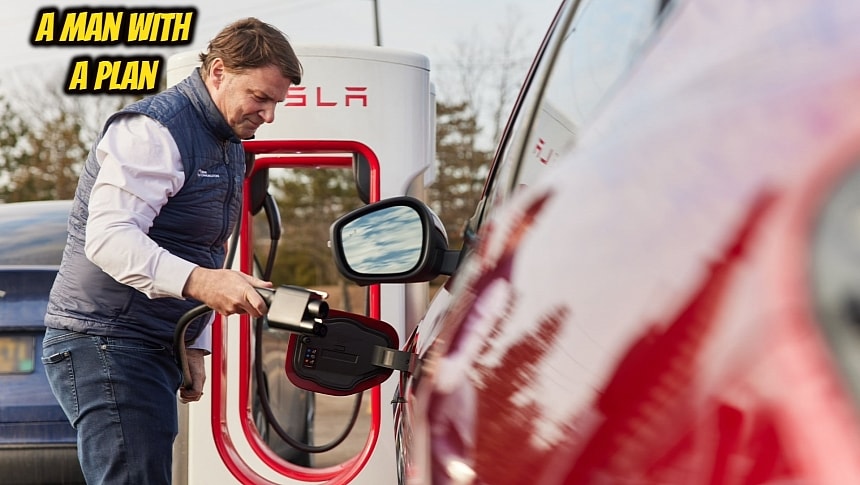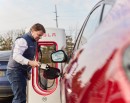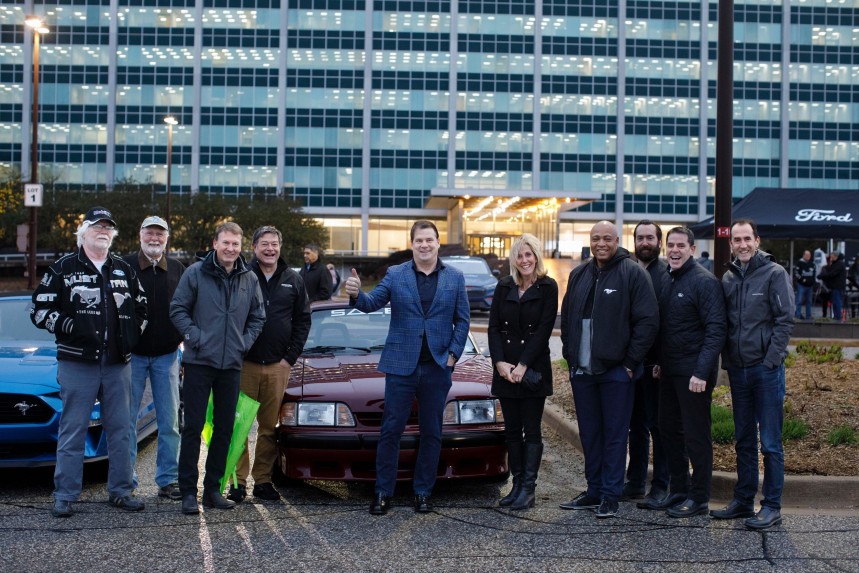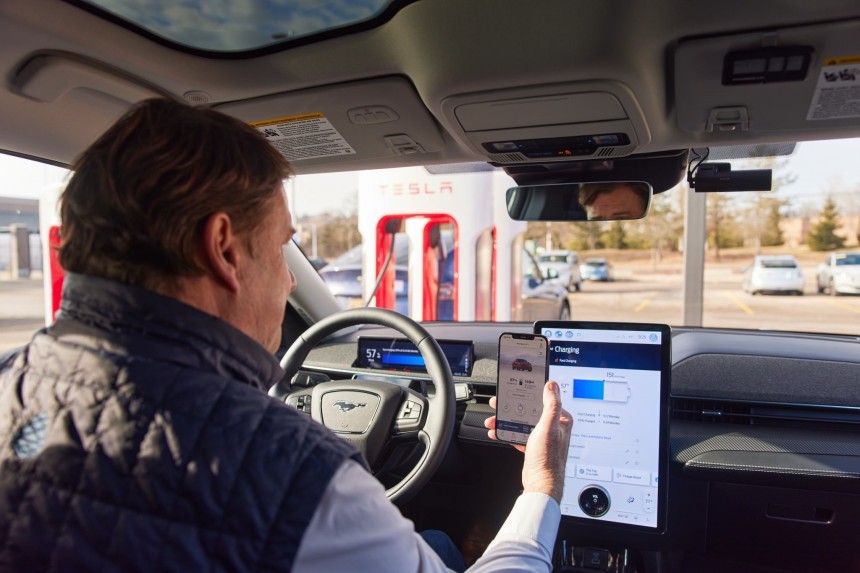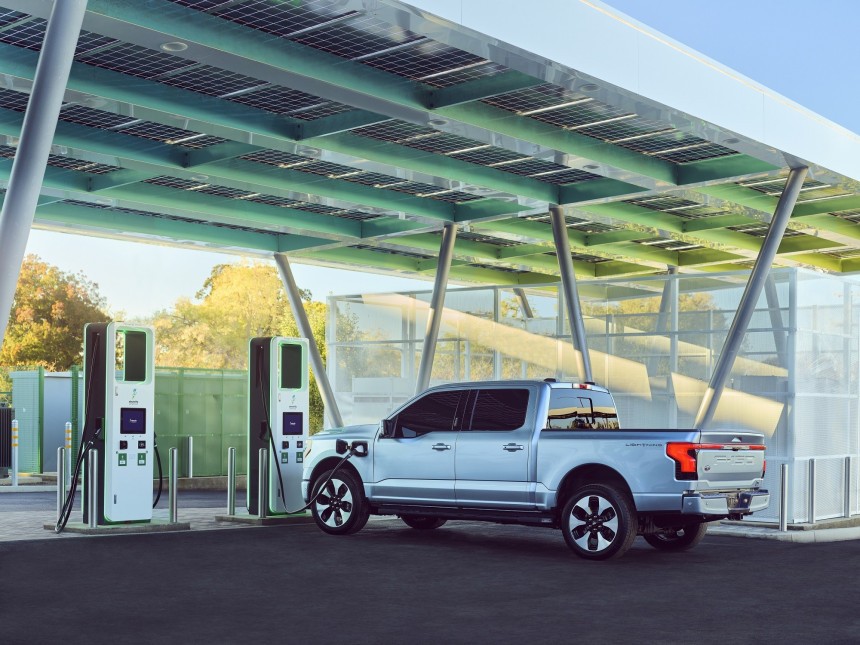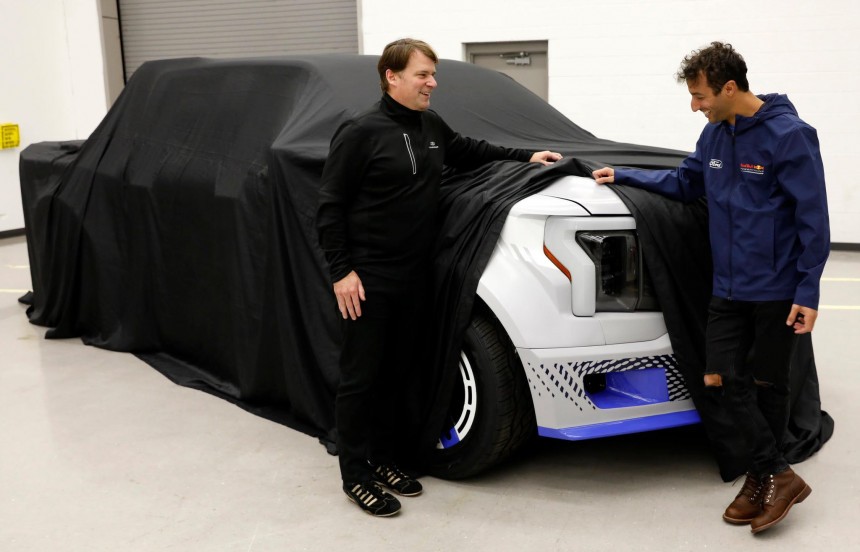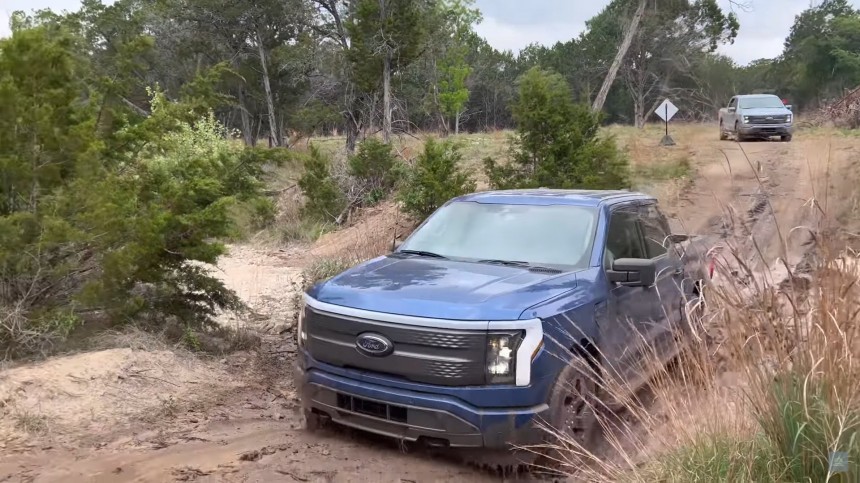If you ask a random person who Jim Farley is, they will probably tell you that they don't know who he is, or they'll confuse him with the late Chris Farley, a well-known American comedian and actor. But for the rest of us, Jim Farley is a gearhead and a well-informed executive who doesn't exaggerate or rush things. Here's what he has to say about the complicated world of all-electric automobiles.
The Blue Oval had ambitious plans for its all-electric vehicle lineup. Although it manufactures only two (the Mustang Mach-E and the F-150 Lightning), the brand wanted to follow in Tesla's, Lucid's, and Rivian's footsteps. Ford also electrified the Transit van, but that one is more suited for commercial customers.
However, it envisioned a unique solution. Instead of abandoning its trusted network of dealerships, it wanted to invite a few of them into a program, the Model e. It was supposed to mature into an entire division.
Besides having a trusted network of dealers, Model e was also supposed to create next-gen EV platforms and the tech that goes with them. Software-defined vehicles are real, and most serious brands are racing to have such rides in their portfolio.
Many automotive companies believe that in the not-so-distant future, in-car technology will become as important as the drivetrain. Although it sounds like pure insanity to someone who has been buying V8- or V6-powered cars all their life, the absence of an engine is forcing carmakers to get creative.
It's also worth pointing out that Tesla popularized the idea that a vehicle can become a computer on wheels. It created an incredible Trip Planner that helps owners plan journeys with ease, introduced games that can be played while stuck at a charger, and integrated popular apps such as Spotify or Netflix. There's even a browser that turns the infotainment screen into sort of an iPad.
But with software comes a host of challenges. Automakers want to have as much control as possible because they don't want to share revenue with Apple, Alphabet, or others. That's why BMW and Mercedes-Benz created a digital store where they put all sorts of upgrades on their vehicles. Remember the heated seats debacle? It was the shy start of a new paradigm.
But so did Ford. It created an online marketplace but didn't promote it. Few people know of its existence. The no-haggle platform is still live when writing, and it's filled with Mustang Mach-E units. That was part of Farley's vision. He wanted to give customers the option to buy a Ford without having to negotiate all sorts of fees, add-ons, or markups. Sadly, it didn't work out the way he wanted, and that's because the dealership model is still too strong to fail or be replaced.
The Model e initiative was also stopped in its tracks because customers preferred to have someone they could talk to over the phone or email. They didn't want to go the Tesla way and do everything via an app.
But that doesn't mean that Farley, who once drove without a driver's license or insurance throughout the country with a Mustang, failed or that Ford backed out of a major change that could have improved car buying. It's just what made the most sense business-wise.
Now, he says that he's fully in love with EVs, and the things that convinced him are not related to their green credentials. He appreciates not having to fill up with gas, the almost instant and effortless acceleration, and decelerating without having to use friction brakes.
The executive also says Ford discovered that the average American drives 150+ miles (241 kilometers) four times a year. In his opinion, almost everyone living in the US would be A-OK with an EV as their primary car, especially since most new battery-powered rides have over 300 miles of EPA-rated range.
Farley used his grandfather, Emmet Tracy, as an example. He started working for the Blue Oval when he was only 14 years old, but his efforts changed his family's journey through life. He even caught the moment when Henry Ford introduced the moving assembly line.
Currently, Ford's philosophy resembles that of BMW in the sense that the Blue Oval gives the customer a choice. Want a Ford? Here, pick between all-electric, hybrid, and pure internal combustion engine (ICE) power.
Farley told NBC's Julia Boorstin that hybrids are more profitable than ICE-powered vehicles for Ford, which is a sign that people want to enjoy the benefits of total electrification but are not ready to make the full switch just yet. So, they choose the middle option, which, as our readers already know, might not be such a good idea.
Still, Farley says what most of us have been thinking for quite some time: regulators need to understand and allow consumers to move forward at their own pace, even if that doesn't align well with international climate goals. Keep in mind that passenger cars represent around 16 percent of America's total yearly greenhouse gas emissions (GHGs), which means our cars are to blame for about 2.5 percent of the global greenhouse gas emissions. It would be great if it could be zero percent, but it's not as bad as some would like you to believe.
However, it's worth noting that Ford wants to beat Tesla at its own game and plans to introduce a compact EV to the market by 2026. It could pull it off, especially since the person at the company's helm is aware that EVs need better aerodynamics, smarter computers, lighter parts, and a simpler build.
Farley is also aware that China is a threat to Western automakers. He points out that 70 percent of all EVs in the world are made in the Asian country and underlines that if you, as an automaker, need processed critical minerals… Well, China is where you have to go. The executive also says the lithium iron phosphate (LFP) batteries, which have little fire risk and can be charged twice as many cycles as NMC or NCA high-voltage energy storage units without risking accelerated degradation, are a protected Chinese innovation.
Farley believes that China bet on EVs when no one was paying attention to them (except Tesla) and, with government support, managed to get a tight grip on the global supply chain. That's why the Inflation Reduction Act (IRA) and the Infrastructure bill introduced so many incentives for automakers, chipmakers, and battery manufacturers. The US wants these companies or new ones to invest in domestic supply chains that support the manufacturing of affordable EVs and create new jobs. Also, Farley agrees with the tariffs on Chinese EVs because they will "level the playing field."
The CEO also touched on self-driving technology and pointed out that modern Ford vehicles with many cameras and sensors on them can't be parked near Chinese government buildings. Moreover, if they want to test or launch self-driving tech in the Asian country, that can only happen through their Department of Defense.
The Chinese problem doesn't stop at batteries, though. They are making chips, too. The average Ford uses around $8,000 worth of non-AI (aka less powerful) chips, which are not made in China. However, many shareholders are asking for cheaper chips. If Ford were to cave to their demands, then it would have to buy them from China.
Ultimately, Ford's big plan is to bet its entire future on the "Skunkworks" team, which is led by former Tesla Model 3 and Tesla Model Y Chief Engineer Alan Clarke and tasked to create Ford's next-generation EV platform and future models. Jim Farley doesn't have access to what that division is working on. The road to total electrification will be interesting for the Blue Oval, its shareholders, customers, and fans.
However, it envisioned a unique solution. Instead of abandoning its trusted network of dealerships, it wanted to invite a few of them into a program, the Model e. It was supposed to mature into an entire division.
Besides having a trusted network of dealers, Model e was also supposed to create next-gen EV platforms and the tech that goes with them. Software-defined vehicles are real, and most serious brands are racing to have such rides in their portfolio.
Many automotive companies believe that in the not-so-distant future, in-car technology will become as important as the drivetrain. Although it sounds like pure insanity to someone who has been buying V8- or V6-powered cars all their life, the absence of an engine is forcing carmakers to get creative.
Intersecting interests
Talking about Apple products… General Motors (on some of its newer rides), Rivian, and Tesla also don't allow their customers to activate Android Auto or Apple CarPlay. Porsche, on the other hand, is willing to go much further – it could soon allow buyers to activate a brand-new CarPlay interface that replaces what the automaker built.But with software comes a host of challenges. Automakers want to have as much control as possible because they don't want to share revenue with Apple, Alphabet, or others. That's why BMW and Mercedes-Benz created a digital store where they put all sorts of upgrades on their vehicles. Remember the heated seats debacle? It was the shy start of a new paradigm.
But so did Ford. It created an online marketplace but didn't promote it. Few people know of its existence. The no-haggle platform is still live when writing, and it's filled with Mustang Mach-E units. That was part of Farley's vision. He wanted to give customers the option to buy a Ford without having to negotiate all sorts of fees, add-ons, or markups. Sadly, it didn't work out the way he wanted, and that's because the dealership model is still too strong to fail or be replaced.
The Model e initiative was also stopped in its tracks because customers preferred to have someone they could talk to over the phone or email. They didn't want to go the Tesla way and do everything via an app.
The Blue Oval's new path to success
Last year, Jim Farley wanted to learn more about how people relate to EVs and what his company should do to make the transition to cleaner powertrains a bit easier for prospective customers. So, he embarked on a road trip with an F-150 Lightning and used high-power public charging networks along the way.Now, he says that he's fully in love with EVs, and the things that convinced him are not related to their green credentials. He appreciates not having to fill up with gas, the almost instant and effortless acceleration, and decelerating without having to use friction brakes.
The executive also says Ford discovered that the average American drives 150+ miles (241 kilometers) four times a year. In his opinion, almost everyone living in the US would be A-OK with an EV as their primary car, especially since most new battery-powered rides have over 300 miles of EPA-rated range.
"Ford's not gonna make it"
Farley believes that his company will not survive unless it makes the switch to manufacturing only EVs correctly, and he wishes that more people talk about the experience of driving an all-electric car rather than debate politics.Currently, Ford's philosophy resembles that of BMW in the sense that the Blue Oval gives the customer a choice. Want a Ford? Here, pick between all-electric, hybrid, and pure internal combustion engine (ICE) power.
Farley told NBC's Julia Boorstin that hybrids are more profitable than ICE-powered vehicles for Ford, which is a sign that people want to enjoy the benefits of total electrification but are not ready to make the full switch just yet. So, they choose the middle option, which, as our readers already know, might not be such a good idea.
Show me the money, honey!
Ford's CEO says that in around five years, automakers could manufacture EVs that are profitable, but they have to think at a smaller scale initially. Large EVs with batteries that cost half of the vehicle's total worth are not the future, which is a weird statement because it makes General Motors' strategy seem misguided. Just look at the Chevy Silverado EV 4WT or RST. That pickup truck has a high-voltage energy storage unit of over 210 kWh, whereas a Rivian R1T or Tesla Cybertruck comes with batteries that are almost half that size.However, it's worth noting that Ford wants to beat Tesla at its own game and plans to introduce a compact EV to the market by 2026. It could pull it off, especially since the person at the company's helm is aware that EVs need better aerodynamics, smarter computers, lighter parts, and a simpler build.
Farley is also aware that China is a threat to Western automakers. He points out that 70 percent of all EVs in the world are made in the Asian country and underlines that if you, as an automaker, need processed critical minerals… Well, China is where you have to go. The executive also says the lithium iron phosphate (LFP) batteries, which have little fire risk and can be charged twice as many cycles as NMC or NCA high-voltage energy storage units without risking accelerated degradation, are a protected Chinese innovation.
The CEO also touched on self-driving technology and pointed out that modern Ford vehicles with many cameras and sensors on them can't be parked near Chinese government buildings. Moreover, if they want to test or launch self-driving tech in the Asian country, that can only happen through their Department of Defense.
The Chinese problem doesn't stop at batteries, though. They are making chips, too. The average Ford uses around $8,000 worth of non-AI (aka less powerful) chips, which are not made in China. However, many shareholders are asking for cheaper chips. If Ford were to cave to their demands, then it would have to buy them from China.
Ultimately, Ford's big plan is to bet its entire future on the "Skunkworks" team, which is led by former Tesla Model 3 and Tesla Model Y Chief Engineer Alan Clarke and tasked to create Ford's next-generation EV platform and future models. Jim Farley doesn't have access to what that division is working on. The road to total electrification will be interesting for the Blue Oval, its shareholders, customers, and fans.
